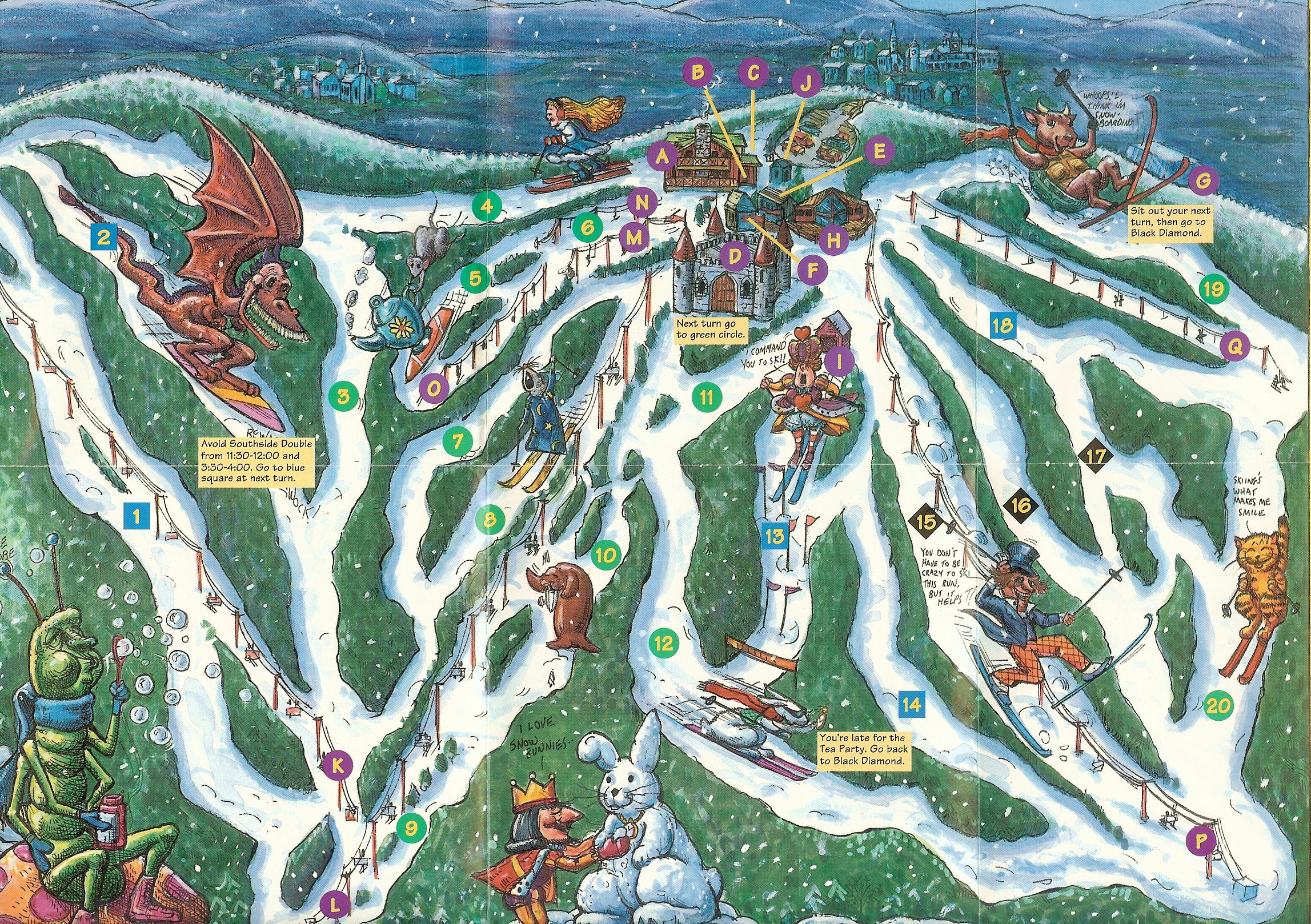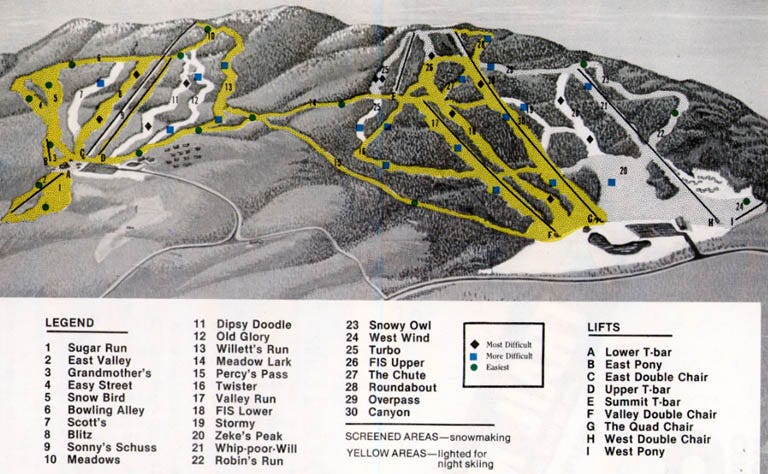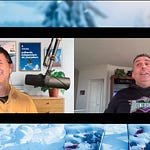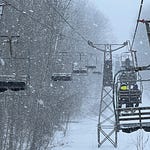Who
Kris Blomback, General Manager of The Mighty Pats Peak, New Hampshire
Recorded on
September 19, 2022
About Pats Peak
Click here for a mountain stats overview
Owned by: The Patenaude family
Pass affiliations: Indy Pass
Reciprocal pass partners: None
Located in: Henniker, New Hampshire
Closest neighboring ski areas: Crotched (30 minutes), Mount Sunapee (30 minutes), McIntyre (30 minutes), Veterans Memorial (50 minutes), Ragged Mountain (50 minutes), Granite Gorge (50 minutes – scheduled to return this season), Whaleback (50 minutes), Gunstock (1 hour), Storrs Hill (1 hour),
Base elevation: 690 feet
Summit elevation: 1,460 feet
Vertical drop: 770 feet
Skiable Acres: 115 acres
Average annual snowfall: 100 inches
Trail count: 28 trails, 9 glades (17% double-black, 12% black, 21% intermediate, 50% beginner)
Lift count: 11 (4 triples, 2 doubles, 2 carpets, 1 J-bar tow, 2 handle tows - view Lift Blog’s of inventory of Pats Peak’s lift fleet)
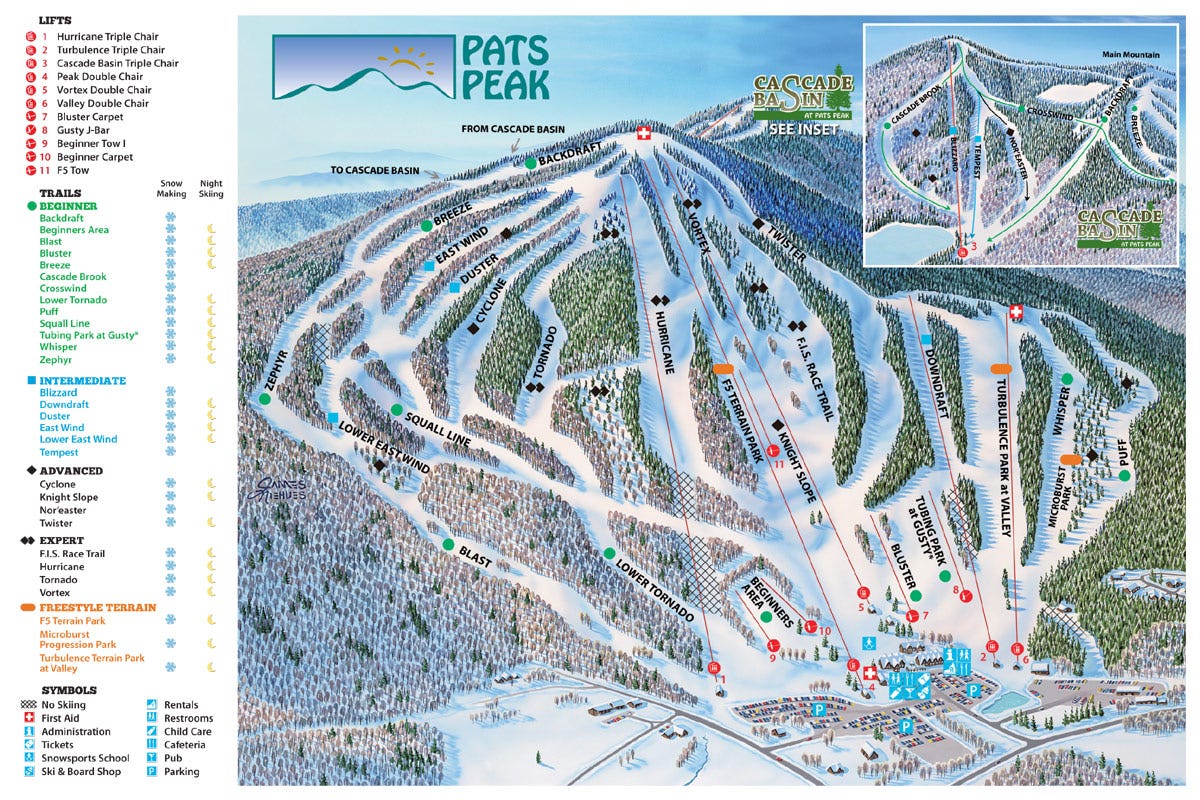
Why I interviewed him
Living next door to Vermont is probably a little like being Hoboken. Nice town, great location, all the advantages of city life, but invisible in the orbit of Earth’s most famous island. Did you know that the population density of Hoboken is about double that of New York City? Probably not. It’s fine. Most people don’t. Nobody cares about Hoboken.
That’s how it seems the ski intelligentsia sometimes views New York, Massachusetts, and New Hampshire, the three ski states bordering Vermont. By whatever accident of geology and meteorology, the Pretentious Beer State possesses most of the region’s biggest ski areas and its most reliable snowzone: the Green Mountain Spine. Along this rim sit your headliners: Killington, Sugarbush, Mad River Glen, Stowe, Smugglers’ Notch, Jay Peak. If you tried to tell me these were the six best ski areas between the Atlantic and the Mississippi, I’d probably be like, “OK” and go eat my Pop-Tarts.
But if The Storm was just a documentary tool for places where New Yorkers vacation, then I would have wrapped this project up two years ago. This is a big New Hampshire house, and always has been: the heads of Loon, Cannon, Gunstock, Waterville Valley, Whaleback, and Ragged have all made podcast appearances. Still, the Vermont interview tally is 15, even though I ski New Hampshire as often as I do Vermont. Clearly I have work to do.
So here we are. A New Hampshire ski area with the best attributes of New Hampshire ski areas: service- and snowmaking-oriented; steep and varied; busy because it’s close to everything; lots of lifts; lots of community and tradition. If you don’t think all that fits into 115 acres, you haven’t skied New England. The Mighty Pats Peak jams it all in just fine.

What we talked about
Reaction to the Jay Peak sale;Ragged Mountain; Pats Peak in the early ‘90s; a brief history of Pats Peak; Blomback’s 100-point list to modernize Pats Peak; “when you operate a ski area 60 miles from the Atlantic Ocean, she’s got something to say about that”; how Pats Peak survived when so many Southern New Hampshire ski areas died; the overcorrection that nearly wiped out Pats Peak’s competition; the problem with debt; thoughts on the pending comebacks of Granite Gorge and Tenney; why the ski area has dubbed itself “the mighty Pats Peak”; knowing who you are; cheapskate expert skiers; who owns Pats Peak; the value of autonomy; what’s kept Blomback at Pats Peak for 31 years; Magic Mountain in the ‘80s; why Pats buys used lifts; where Pats’ current lifts came from; which lifts are next in line for an upgrade and what may replace them; the poor-man’s detachable; a history of (non-mechanical) high-speed lift fails in New England; the “magic length” of a detach; ski areas are littered with dead halfpipes; some unique attributes of Mueller lifts; whether it’s a pain in the butt to have chairlifts made from a half-dozen different manufacturers; why Vortex rarely has liftlines even when the bottom triples have 20-minute waits; how Pats Peak crushes its larger competitors in snowmaking on a regular basis; the ski area’s audacious goal to go from nothing open to every trail open in 48 hours; the history, purpose, and experience of Cascade Basin; additional trail and glade expansion opportunities; snowmaking in the glades; why Pats Peak was an early Indy Pass adopter; Pats Peak is the third-most redeemed Indy resort and I mean damn; why Indy draws so many first-time visitors to Pats Peak; a new reason to hate Liftopia; Indy Pass D-day at Pats Peak; reaction to Vail entering New Hampshire; competing with the Northeast Value Epic Pass; “skiing is an experience”; the logic of over-staffing; “service and experience is what sets Pats Peak apart”; and competing against Vail’s $20-an-hour minimum wage.
Why I thought that now was a good time for this interview
As the Indy Pass settled in over the past three years, an interesting pattern has emerged: New England absolutely crushes the rest of the country in total redemptions. During the 2020-21 ski season, six of the top 10 resorts by number of Indy skiers were in New England. Last season, that number rose to seven of 10. With long, cold winters; generation-spanning ski traditions; and incredible population density, these results weren’t surprising so much as affirming of what anyone who has skied out here already knows: the Northeast loves to ski.
But there’s data within the data, and surprises abound. Those seven New England ski areas do not stack up according to vertical drop or skiable acreage or average annual snowfall. Sometimes, as in the case of perennial Indy number one Jay Peak, mountain stats – especially 349 inches of average annual snowfall – do trump distance. By the statistical standard, no one is really surprised to see 2,020-vertical-foot Waterville Valley sitting in the two-spot. But statistical assumptions break down after that, because instead of 2,000-plus-footers Cannon or Saddleback claiming the third spot, you have the Mighty Pats Peak, with a third of the rise and a bunch less snow.
There are a few obvious contributing factors to the ski area’s Indy rank: Pats Peak is the easiest mid-sized ski area to reach from Boston; the mountain had zero Indy Base Pass blackouts until this coming season; Crotched, its closest competitor, was constrained in operating hours and open terrain last year; it’s open all the time – nearly 90 hours on peak weeks. But those attributes alone aren’t enough to explain how a 770-vertical-foot mountain finished number three out of 82 – 82! – Indy Pass partners for total redemptions last season.
A succession of bigfoots were expected to stomp Pats Peak flat over the past three decades, Blomback tells us in the podcast. SKI, Peak Resorts, Vail. But business has never been stronger. The product on the snow doesn’t just matter a lot, it turns out – it matters more than anything.
Questions I wish I’d asked
I already have a bad habit of keeping my guests way too long, but, believe it or not, there are almost always un-asked questions remaining at interview’s end: why are all Pats Peak’s trails named after winds? How important is it to retain some New England indies as Jay Peak joins a conglomerate? How can Vail make sure Crotched is as good as Pats Peak from a snowmaking and open-terrain point of view? How are season pass sales going? And on and on. Somehow I usually have the sense to keep these under two hours, but that rises more from guilt over time theft than any sense of personal decency.
What I got wrong
I think I mispronounced “Patenaude” – the last name of the ski area’s owners – about every way that it could be mispronounced over the course of an hour-long interview.
Why you should ski Pats Peak
As you can imagine, I possess a lot of ski passes. And despite the lack of an in-town bump, I can reach around 150 of them within a five-hour drive. So my options on any given day are fairly vast. While my travels – well documented on Twitter, Instagram, and the “this week in skiing” section of the weekly-ish news update – may seem random, I am almost always chasing snow and conditions. Who, within that vast radius fanning off New York City, is firing? Eerie? Ontario? The Green Mountain Spine? The Whites? And what’s the path of least resistance? If the Catskills get hammered, I’m unlikely to plow through to the Adirondacks. If the Poconos get their once-every-five-year dump, I’m going. Almost any ski area can deliver a riotous day with the right conditions. The secret trees pop open. The jumps and drops are more forgiving. The ice evaporates and for one afternoon you can close your eyes* and pretend you’re in Utah.
But sometimes it doesn’t snow anywhere. And I still have to ski every week because you know why. Last December-to-January we hit just such a hellstreak in the Northeast. The kind that makes you wonder how long an industry reliant upon temperatures below freezing can stitch together sustainable seasons. The fats were all in various states of open but many of the littles sat brown-hilled and empty over Christmas week. No one was offering anything resembling their trailmaps.
Except Pats Peak. One hundred percent open by the first day of 2022. And why? It was weird. Its base elevation is 690 feet. The mountain sits in Southern New Hampshire, outside of the major snowbelts. Unlike similarly sized Crotched, right down the road, it’s not owned by a CorpCo that can helicopter in snow from the Wasatch. It’s just a 770-foot local bump owned and operated by locals.
And yet there it is, routinely the first ski area in New England to pop its full menu open for the season. How? “We often joke we’re a snowmaking system with a ski area attached,” Blomback tells me. Go there and you’ll see it. That’s what I did in January. And there: Unimaginable snowmaking firepower. Gunning anytime temperatures allow. Day or night, chairlifts spinning or idle. A plume of white powder erupting from the stubborn brown hills around it.
And guess what? The skiing is pretty good too. From the parking lot the ski area erupts, fall lines apparent. Lifts everywhere. In the backyard a hidden pod, Cascade Basin, like a second miniature ski area of its own. Glades tucked all around. Weekdays it’s all yours. Until school lets out. Then it belongs to the kids. Busloads of them, learning, racing, messing around. To the baselodge, and one of the great bars in New England skiing.
Just remember to make your Indy Pass reservation first. The information era has been good for the mighty Pats Peak. Real-time weather and trail reports have made it obvious who’s mastered the snowmaking game. Pats Peak isn’t the only snowmaking killer in New Hampshire. But I’d argue that there’s no one better. I’m not the only one. The place parked out for the first time last season. Blomback and team quickly adjusted, limiting Indy Pass slots and bringing back the Covid-season reservation system. This year, Pats Peak will have Indy Base blackouts for the first time. But these won’t matter in mid-December when the big bombers are five percent open and Pats Peak is breaking out new terrain out daily.
*Actually maybe don’t do this.
Podcast Notes
Blomback notes that, “at one time, in southern New Hampshire, we lost King Ridge, Ragged, Whaleback, Crotched, Temple, Highlands, and Pinnacle.” Ragged, Whaleback, and Crotched are obviously back, and Pinnacle is orchestrating its second comeback as Granite Gorge. But here’s a quick look at the others:
King Ridge
Vertical drop: 775 feet; Lifts: 2 triples, 1 double, several surface lifts
This was a terrific little ski area that made the mistake that just about every terrific little ski area made in the ‘80s: it decided that snowmaking was a fad. Then it dropped dead. Really the important thing about King Ridge though is that it has the single greatest trailmap ever printed (circa 1994):
Temple
Vertical drop: 600 feet; Lifts: 1 quad, 1 double
This little spot, just down the road from Crotched, ran for 63 seasons before shutting down in 2001. The quad now stands at Nashoba Valley, according to New England Ski History. The state purchased what was left of the ski area in 2007 and let it fade back into nature.
Highlands
Vertical drop: 700 feet; skiable acres: ; Lifts: 1 triple, 2 T-bars, 1 pony, 1 ropetow
Highlands stood as a ski area from the late ‘60s to the mid-90s. Today, it’s the only lift-served mountain-bike-only area in New England (the rest all offer wintertime skiing). This one, seated just a few minutes off I-93, seems like a good candidate to re-open for skiing at some point, perhaps with a parks focus.
Crotched East
While Peak Resorts famously resuscitated the then-long-dead Crotched in 2003, they did not revive all of it. The ski area was once a two-sided operation, consisting of Crotched East and West (also known as Onset or Bobcat). West is present-day Crotched. East sits right next door, liftless, fading away. I doubt Vail has any ambitions to revive it, though they could certainly use the extra capacity. Crotched circa 1988:
And this is what survives today:
Similarly, Magic Mountain, Vermont has an abandoned ski area on the backside (which you are still allowed to ski, though the lifts are long gone). Here’s what the place looked like in its 1980s ultimate form, when Blomback worked there:
Magic today:
Blomback and I discussed the phenomenon of the Vortex double chair, which terminates just alongside the Hurricane and Turbulence triples, but rarely has a line, even when the other two are backed up for 20 minutes. This, Blomback says, is because the double loads above the lodge, rather than continuing the 50 vertical feet to the true base at the Peak chair. The same phenomenon happens all over, but the similar instance we discussed was Sunday River’s Locke and Barker chairs. Locke, a triple, rarely has a line, while Barker – a high-speed quad – often has lines longer than the gestational cycle of several species of mammal. Why? I don’t know. There is a lot of terrain crossover between the two lifts. The main difference is that one is faster (and racers often commandeer large chunks of Locke). I’ve always wondered what would happen if Sunday River were to bring the Locke loading station down beside Barker? Unless they upgrade it to a high-speed lift, I can’t imagine it would matter much – which is fine with me, as I’ll lap the slow lift with no line all day long:
The Storm publishes year-round, and guarantees 100 articles per year. This is article 102/100 in 2022, and number 348 since launching on Oct. 13, 2019. Want to send feedback? Reply to this email and I will answer (unless you sound insane, or, more likely, I just get busy). You can also email skiing@substack.com.







